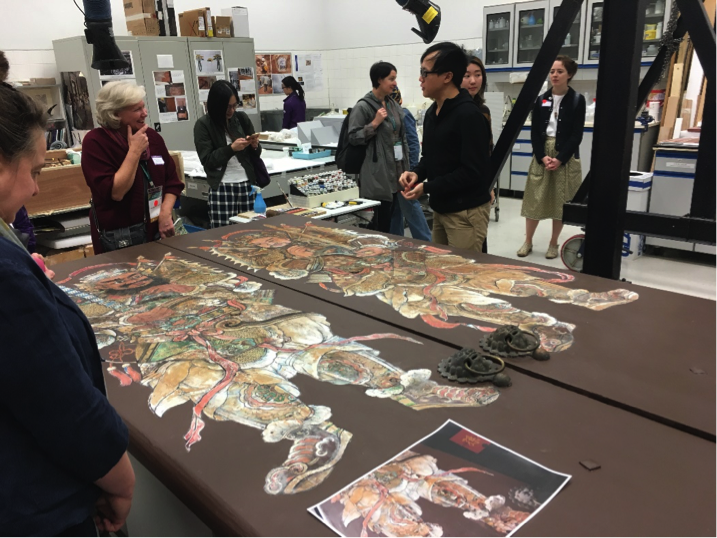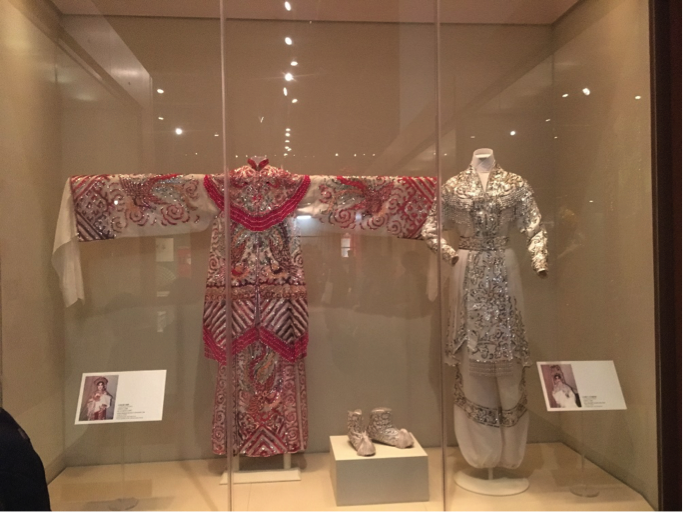From the 24th to the 26th of November 2017, I had the exciting opportunity to attend the IIC-Palace Museum 2017 Hong Kong Symposium, held in the Chiang Chen Studio Theatre at the Hong Kong Polytechnic University, Hung Hom Kowloon. The theme for this symposium was “Unroll and unfold. Preserving textiles and thangkas to last”. As an AXA Art Asia scholarship recipient, I was interested in attending this symposium to gain more knowledge regarding the conservation of rolled textiles, knowledge which I felt would assist with a current project at the Museum of Applied Arts and Sciences documenting and rehousing approximately 1600 rolled textiles.
This symposium brought together over 200 textile conservators and collectors from around the world, keen to share their wisdom and experience. An excellent selection of 18 international speakers discussing a wide variety of topics made for an engaging and motivating program.
After opening remarks from Sarah Staniforth, IIC President, Michelle Li, Director of Leisure and Cultural Services Hong Kong and Jirong Song, Deputy Director of The Palace Museum Beijing, four sessions followed, spanning the Friday and Saturday.
The session themes were- Conservation and Historical Studies on Thangkas, Textiles Along the Silk Road, Court textiles and Ethnic Costumes and finally Crafts and Art of Textile Artefacts.
Several speakers and ideas left a lasting impression on me. The first was an understanding of three different approaches to the conservation of thangkas. In the first session, Jirong Song from The Palace Museum Beijing discussed the conservation of painted thangkas hanging in the Immortals Pagoda Buddhist Hall of the West Warmth Chamber of the Hall of Mental Cultivation in the Forbidden City, with an emphasis on the treatment of the ‘Kurukulla’ thangka. Her approach to conservation highlighted the disciplined, scientific and methodical approach of conservation practice in a museum situation. There are approximately 2000 thangkas in the Forbidden City collection with approximately 1500 thangkas in storage. Issues such as dirt, cracking, loss of pigment, tears, deformation due to long term hanging, fading and dye running affect the thangkas, some of which date back to 1747. A thangka is a Tibetan Buddhist painting on cotton, silk appliqué, or human skin usually depicting a Buddhist deity, scene, or mandala. Kurukulla is considered to be the Cupid of Tibetan Buddhism.
Teresa Hardy, a textile and ethnographic conservator of over twenty years’ experience, discussed a different approach to the conservation of thangkas, developed while she was working in the field in Mongolia, Tibet, Nepal and China. Recognising that museum-style conservation treatment protocols were not suitable for in-situ conservation work due to the availability of supplies and equipment in isolated areas, Teresa developed simple but effective solutions requiring very little equipment and easy to obtain supplies. Her techniques could be taught to local people who could then become the carers of the thangkas in their places of worship. A very different but equally valid approach to the methods used at The Forbidden City in Beijing.
The third approach was outlined by Ann Shaftel, a Fellow of the International Institute for Conservation of Historic and Artistic Works (FIIC), a Fellow of the American Institute for Conservation of Historic and Artistic Works (FAIC) and a member of the Canadian Association of Professional Conservators, ICOM-Canada. The speaker’s key point was that ‘Impermanence’ is fundamental to Buddhist teaching, which presents a challenge for conservators. It was emphasised that conservators must be respectful of the continuous cultural use of thangkas. Thangkas are hung in monasteries, they are touched, moved, and used by worshippers and can also be exposed to a wide range of environmental conditions while on display. Ann Shaftel has developed a program called ‘Treasure Caretaker Training’ where she teaches conservation of thangkas and other cultural treasures through education within the monasteries, at all times respecting that thangkas are designed to be used.
These three approaches to the conservation of thangkas spoke of the need for conservators to be flexible, resourceful and respectful of the culture and situation of the object and community.
Another interesting presentation was delivered by Franca Cole, Research Fellow and Visiting Curator in Archaeology and Conservation at the Sarawak Museum, East Malaysia. Franca spoke of a fascinating archaeological site in the Libyan desert called Ghirza. Originally a Roman mausoleum site, archaeological research has shown that it was re-occupied in the fifth and sixth centuries and then again in the ninth to eleventh centuries. A sealed cache was found during an archaeological dig in the 1950s revealing a collection of coins, wooden mirror boxes and surprisingly a collection of over 80 textiles and large decorative fragments. The textiles appear to have originated from several different regions, determined by their method of manufacture and fibre identification. No explanation has yet been determined as to how these textiles arrived in a small outpost in the Libyan desert some 130km from the Mediterranean coast. This presentation opened a discussion on how to conserve excavated textiles and how these approaches differ from traditional techniques of textile conservation.



The final day of the symposium included a choice of tours which included a visit to Jody Kan’s Cheongsam making studio, a Tai Ping Shan Historical District Heritage Walk, Tin Hau Temple and Intangible Cultural Heritage Tour around the Yau Ma Tei District and a Behind-the Scenes Tour of the Conservation Laboratories. I chose the behind-the-Scenes tour of the Conservation laboratories which are located at the Hong Kong Heritage Museum, Sha Tin, Hong Kong. Textile, large objects and paper conservation is completed at this museum. I had the opportunity to observe the analysis of synthetic dyes in historic Chinese wedding documents, the treatment of a large pair of painted wooden gates and the treatment of Chinese children’s hats. After the conservation laboratory tour, I was able to spend some time strolling through an exhibition of Chinese Opera costumes on display at the Hong Kong Heritage Museum.
This symposium allowed me to talk with textile conservators from around the world and gather ideas for best practice in the conservation of rolled textiles.
A whirlwind experience and very enjoyable.
Plans for a 2020 symposium celebrating the 600th anniversary of The Palace Museum are currently underway.